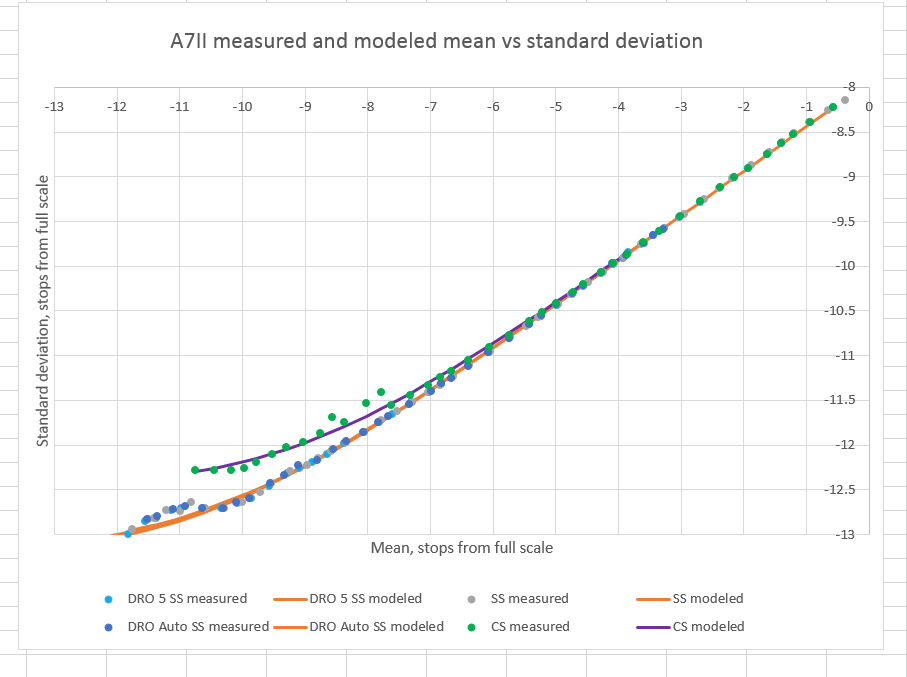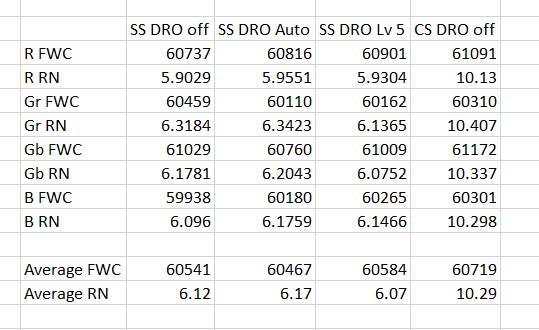I’ve been asked to look at whether the Sony alpha 7 Mark II Dynamic Range Optimizer (DRO) affects noise at low ISOs.
I ran a photon transfer curve with the camera set four different ways:
- Shutter mode single shot, DRO off
- Shutter mode single shot, DRO Auto
- Shutter mode single shot, DRO Lv 5
- Shutter mode continuous high, DRO off
Here are the curves:
The vertical axis is the standard deviation (sigma) in stops from full scale. The horizontal axis is the mean (mu) in stops from full scale. The dots are measured values. The lines are values from a camera model fitted to the measured values in each of the four sets. All of the single shot points and curves are materially the same.
The continuous shutter curve is different, and a fair amount worse, than the other three. We saw in the a7 testing that the camera went from 13 bits of precision to 12 bits when the shutter mode was changed from single shot to continuous. I’ll check, but I’m betting that the a7II does the same. This will increase the quantization noise, which, in my testing, is indistinguishable from the rest of the read noise.
Let’s look at the parameters of the camera models derived from the measured data:
The modeling program generates an independent camera model for each raw channel which are identified as R, Gr, Gb, and B. FWC stands for full-well capacity, and is measured in electrons. RN stands for read noise, and is likewise measured in electrons. SS stands for single shot mode.
All the single shot models are virtually identical.


Hi Jim, thanks for the effort, but frankly I and probably others can’t understand what you have been doing and what the results actually indicate. You did not tell what you actually did (like setting up the camera (which by the way, I assume the A7II) for a specific scene and repeating that with different DRO settings.), why some curves are different than others and how this proves whether DRO is baked into RAW or not ( I agree that it isn’t).
Regards, Chris
Looks like you need some background on photon transfer curves.
http://blog.kasson.com/?p=8050
http://blog.kasson.com/?p=8055
http://blog.kasson.com/?p=8077
The only curve that is different is continuous shutter, where Sony changes the bit depth.
Jim
Thanks for the test but can you put into layman terms what the results are? From what I can see, I decided to avoid continuous shooting as much as possible for best quality but does DRO affect noise or not? I shoot RAW+JPEG just in case.
Thanks
DRO doesn’t affect noise in raw images. I didn’t test JPEG, and don’t intend to, so I can’t help you there.
I only care for RAW in reality so I am good there then. One thing I notice is that when you choose DRO, the camera will normally use a lower ISO (keeping aperture and shutter speed the same that is) than when shooting with DRO off so you end up with cleaner images with DRO from my quick tests.
I do prefer to turn it off when shooting outside with good light but for low light where higher ISO is needed and where there are some dark and bright areas, it seems DRO is a better choice.
I must test more though.
Sounds like you’re using auto ISO. Is that right? I never use it, so I don’t know how it interacts with DRO. Since you only care about raw, and DRO doesn’t affect the raw files, why not just turn DRO off forever?
Jim
Because somehow with AutoISO when using DRO on a scene like I mentioned above where there is dark and bright areas, with DRO I was able to get what looks to my eyes as the same overall exposure of bright and shadow details yet at a lower ISO setting (select automatically) thus less noise on the image.
Didnt notice any tradeoffs at least on that particular test.
I will work on more tests on Monday when I have 3 days off in a row. 🙂
Oh and because I shoot both RAW + JPEG since for some images I am ok with the JPEG results thus is nice to have as good of a result as possible although for anything I care about, RAW is what I will develop so perhaps is not even worth testing indeed.